WA8LMF Mirror of WB4APR Website - 21 July 2008
PCsat
 PCSAT-1, A Naval Academy Amateur Radio Satellite
PCSAT-1, A Naval Academy Amateur Radio Satellite
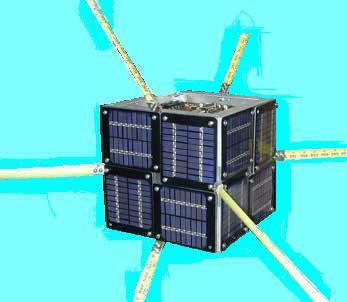
US Naval Academy Satellite Lab, Bob Bruninga, WB4APR, Engineer
Students: Goodhiew 97, Morgan 98, Lundberg, Scrabeck, Gomez, Melanson, Kollar, Mattera, Ortiz 99
Students: Burroughs 99, Schwenzer, Nolan, Lawrence, Boutros 2000, Sullivan, Gutweiler 2001
Machinest: Mike Spencer
NAVy OSCAR-44. object number 26931 --- PCsat (Fully Operational in Feb 08)
FREQUENCY: 145.825 MHz.
DIGIPEATER PATH: via W3ADO-1 (or via ARISS if enabled)
This Page is in reverse chronological order. Newest stuff is first.
See also the PCSAT live downlink page
(last 50 stations heard via PCsat).
FEB 2008 OPERATING WINDOW: . PCSAT-1 entered full sun on 9 Feb and will be
fully operational in support of the AMSAT
Satellite Simulated Emergency Test (SSET). . This test
demonstrates the ability of Amateur Satellite operators to send emergency messages
from a devistated area using simple handheld or mobile radios. . This period, no
attempt will be made to keep the satellite loaded with the PCSAT-1 callsign. .
Instead, we will let all operations use the W3ADO-1 callsign for consistency since
it will go back to that after each crash. . We are using side B for keeping the
commands loaded to maintain positive power budget, but isolating both sides so
that crashes on side A to not affect side B.
ALIASES SUPPORTED: ARISS, APRSAT and (After crashes, W3ADO-1).
FALL 2007 OPERATING WINDOW: . PCSAT-1 was fully operational from
2 to 20 November 2007 . During this full sun period,
PCSAT-1 shared the 145.825 MHz
frequency with ANDE and the
ISS for a great multi-satellite
constellation period in support of the first
SSET.
. Some dual hop packets were also recorded. . At the same
time the GO32 Satellite is also fully supporting
APRS communications (at 9600 baud). .
During this operating period a new operating technique was implemented to
reduce the number of duplicate packets being attempted by users. By
changing the aliases on PCSAT-1 to only support the WIDEn-N path, the
satellite could enfore a restriction of only one duplicate packet per minute
per user. This significanly reduced the overload conditions over Europe.
See how the WIDEn-N configuration
works to reduce channel load.
JANUARY 2007 OPERATING WINDOW: This PCSAT-1 full-sun recovery period lasted from
1 to 19 Jan 07 and saw one of the highest activity periods in years (over 100 users per
day). This was heightened by
the deployment of ANDE and RAFT on 21 Dec 06 to
join PCSAT-1 as a constellation of three APRS digipeating satellites on 145.825. PCSAT-1
continued to operate back into eclipses up to 28 minutes long (out of a max of 35) before it
was lost again on the 19th.
FALL 2006 OPERATING WINDOW: From 26 Sept to 11 Oct 2006, PCSAT-1 was fully
operational in full Southern Sun. When recovered, she operates as PCSAT-1
and supports the aliases of APRSAT, ARISS and WIDEn-N.
If you see the default W3ADO-1 callsign then she is running down every orbit
in the dark and does not have enough energy for most packets.
SPRING 2006, JOINT OPS WITH PCSAT2: The spring full sun period lasted 16 days
from 8 to 24 March 2006. On the 10th, its companion PCSAT2 on the ISS was switched to 145.825
for joint operations to experiment with dual satellite-to-satellite hops.
Many dual hop packets were observed including this longest path so far:
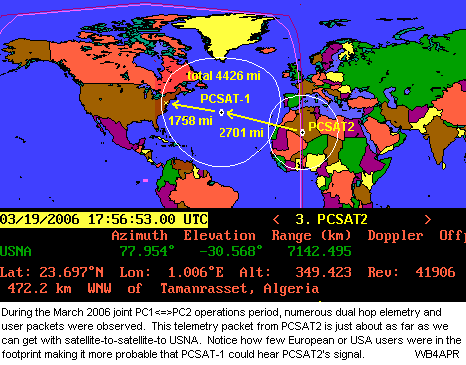
SPECIAL EVENT 2 Dec 2005. Annual Army/Navy game Football Run:
PCSAT-1 participated in this annual event by supporting position reporting and
tracking of the special
Army/Navy game ball from Annapolis to Phily.
The 120+
students in the 13th company each run the ball in relay teams over the 128
miles from Noon on Friday to arrive for the game the next morning.
FALL 2005, OPS NORMAL 25 Nov to 17 Dec 2005:: During this full sun operating
period, we switched
PCSAT2 to the 145.825 frequency for joint dual-satellite
operations with PCSAT-1.
Here is a double hop telemetry packet we received from PCSAT2 via PCSAT-1:
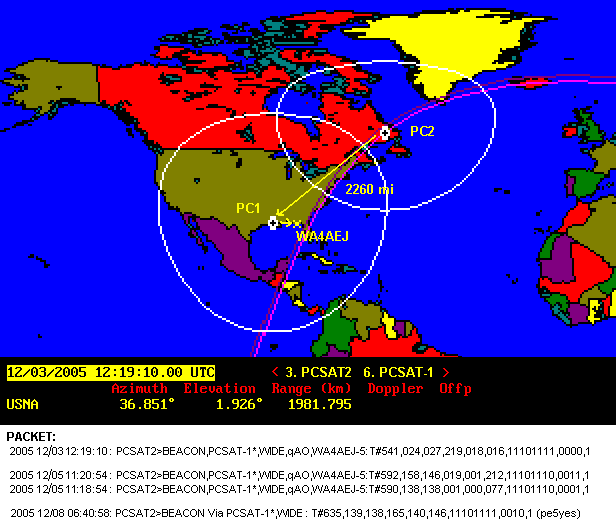 and
the later 12/05 pass
and
the later 12/05 pass
JANUARY 2005 JOINT PCSAT/ISS TEST: From 24 Jan to 16 Feb, PCSAT-1 was
recovered to full operation. On 2 to 4 Feb 2005, the ARISS packet system on ISS
moved to the PCSAT frequency of 145.825 for joint operations with PCSAT.
In addition to doubling APRS satellite coverage
for several days, we detected 3 successful dual-satellite communications paths.
Very high activity was observed on both systems. .
Typically 70 or more operators per day...
PCsat Model On Display: at the Udvar-Hazy Smithsonian Space Center near Dulles Airport.
photo.
OPERATING GUIDELINES:
During normal operations, users are requested to only operate in accordance with
the User Service Agreement
FALL 2004 OPERATING PERIOD: PCSAT-1 operated for a month starting 24 Oct 2004.
DECEMBER 2003 OPERATING PERIOD: PCSAT-1 was recovered for month starting on
15 Dec 2003, when her orbit entered a period of full sun.
As of 1 Feb 2005, PCSAT-1 will have logged 42 months in space and has
logged over 2678 individual users.
Magentic Stabalization: See
plot of +Z current versus latitude that confirms
our passive magnetic attitude alignment.
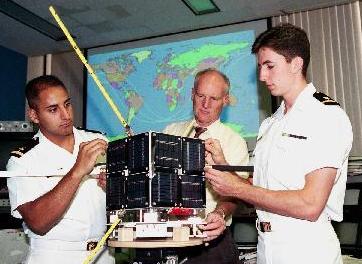
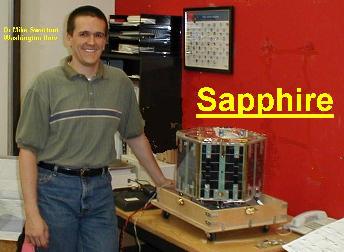
Sapphire Revived! On 5 Nov, 2003, Mineo Wakita, JE9PEL, a JAMSAT member sent the
RESET commands to Sapphire and this allowed command stations to regain control of this
satellite. Sapphire and PCsat were launched on the same launcher and Sapphire is a
joint project between the Naval Acadmey and the builders of Sapphire at Washington
University and earlier at Stanford.
(See original
Sapphire WEB page) . Now Sapphire joins PCsat as a digipeater in the APRS
constellation of satellites called
ASTARS.
FALL 2003, OPERATING PERIOD: PCSAT-1 returned to full health from 13 Sept to 9 Oct 2003
in full Sun and supported 50+ users a day on the
live downlink page!
FULL SUN PERIODS: PCSAT-1 was prematurely declared dead when she would not respond
during the last phase of full Sun, on 10 July. Subsequently we discovered
that she works quite well even during
max eclipses when the +Z solar panel (our best)
during a noon time northern hemisphere pass is pointed
directly at the Sun. .
Since we are having student telemetry labs soon, here are some capture files the
students took of high-rate telemetry this month.
1605z 3 Sept 2003.
1540z 4 Sept 2003.
1339z 15 Sept 2003.
2157z 16 Sept 2003.
1238z 17 Sept 2003.
1404z 01 Oct 2003.
1458z 07 Oct 2003. <== short file, but Side A/B were crossconnected
Click here for our Telemetry format and equations
for use in decoding these files.
PREMATURE EPITAPH (posted July 17th): PCsat appears to have died after 21 months,
10 days. We commanded her well on 10 July (both sides), but she did not make it to the
17-31 July full sun period when we expected her to bounce back to life.
She died 7 days short. . [POSTSCRIPT: We have since learned that she dies every
summer even in full sun, while she is fully recoverable evey winter in full sun...]
SPECIAL EVENT, FIELD DAY 2003:
We were able to properly configure PCsat for two passes over the National Emergency
Communications weekend called Field Day (last weekend in June).
On Saturday, an hour before FD officially began, and then
Sunday, one hour before it ended:
Saturday we saw: KB1GVR, WB4APR, VA2VA, KB2ZE, N3ZLL-5
Sunday we saw: VE3TKB, KE2T, N9YUK, KB1GVR, N1FD, W3ADO, VE3DOH, WB4APR
END OF MISSION: PCsat was in full sun 10-20 April 2003 and continued to be power
positive until 26 April. At that point it was back into heavy eclipses and the
batteries were so weak that even in the sun, they can barely support a single packet.
For official purposes, we declared PCsat mission as complete.
It operated reliably for 19 months and
supported over 2000 users worldwide. We were seeing typically 50 users in each 8 hour
period on pcsat.aprs.org. So she has been well used. PCsat will remain ON for
continued experimentation, but the only packets you can probably get through PCsat now are
very short ones. Here are several ways to generate short packets:
Mic-E formatted Packets (position, Course, SPeed and ICON)(only 9 bytes in the payload)
Kenwood D7 and D700's use the Mic-E format (Turn off any status text)
Transmit VIA XBAUD and your 1 second 1200 baud packet will be digipeated
back down at 9600 baud
Set your radio to crossband and TX at 9600 baud on the UHF input.
RECENT NORMAL OPERATIONS: PCsat was in full sun 11-26 Feb and continued normal
operations in positive power budget for 47 days to 30 Mar 2003.
Prior to that, the previous Full Sun period was 9-22 Nov 2002.
But with dilligant oversight by the command stations around the world keeping her in low
power modes, she was fully operational until a reset on 1 Jan 03 during a nighttime pass
over Europe which put her back in daylight-only operations. PCsat is always usable during
the day. As of 14 Feb 2003 over 1950 stations had used PCsat
See list.
BBS EXPERIMENT: During the March full sun period, we activated
the PCSAT BBS. It has no RAM backup battery, so it was never a formal part of the
PCSAT mission, but during the 2 week period, over 70 users sent and received messages
via the BBS. The BBS is now OFF and should not be used. It is a power hog due
to all the RETRIES and inefficiencies of trying to use connected packet on a satellite
and as such was never part of the mission.
ex-N5JXU alerted us to the WEB page for the HARP radar in Alaska. It captured PCSAT
as shown below:
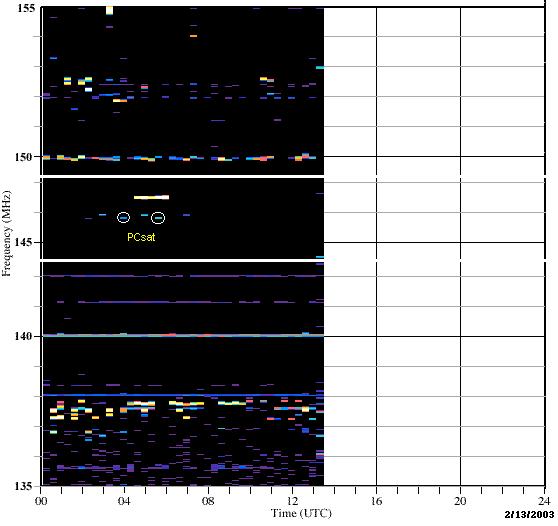
This chart is a waterfall plot of the readings taken by the
HARP Monitor.
Spectrum samples are taken at 20 minute intervals throughout the day.
The color indicates intensity, from deep blue to red.
 There are a few remote environmental sensor projects that use PCsat or its cousins of
ISS or UO22 for reporting remote data back to the worldwide APRS system. This one is
in the Arctic and there are
two in Antarctica. See
more about Buoys
There are a few remote environmental sensor projects that use PCsat or its cousins of
ISS or UO22 for reporting remote data back to the worldwide APRS system. This one is
in the Arctic and there are
two in Antarctica. See
more about Buoys
.
PCSAT FOLLOW-ON MISSIONS: There are two PCsat type digipeaters in work.
ANDE Is a 1 year battery powered digipeater and
PCSAT2 is a 1 year external attachment for the ISS.
SPECIAL JOINT ISS TEST: From 11 Oct to 30 Oct, the ISS digipeater QSY'ed from its
normal 145.800 frequency to join PCsat on 145.825 for some joint operations tests flying
as the first ever two satellite constellation in the Amateur Satellite Service. The
test was successfulwith 13 stations completing double hop packets between both
spacecraft over distances as great as 1880 miles. See the
Summary Report or original
Test Plan.
The following image from APRStk.exe shows the geometry of the second reported success
on 22 October over the USA.
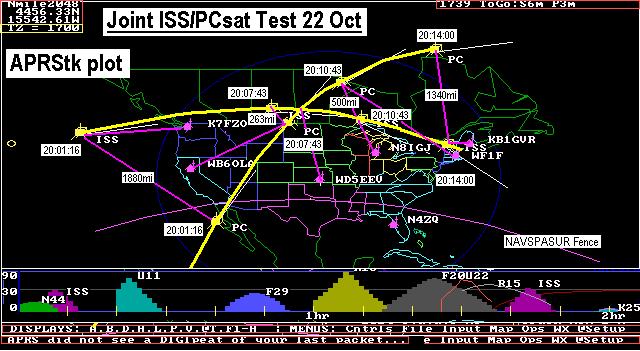
This second test followed 6 days of ISS being off the air. This time K7FZO on the west
coast was the first successful packet and established a new DX record for joint satellite
hop of 1880 miles. At the end of the pass over the East Coast, another DX hop of
1340 miles was made by KB1GVR in Maine.
Click for Details
Previously on 12 October were the first 5 successes over the East coast of the USA as
shown below.
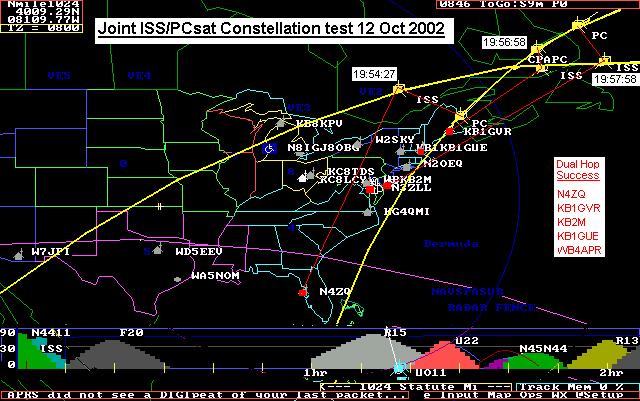
At 19:54:27 N4ZQ got the first dual hop packet through ISS and then PCsat. Then a minute
later as PCsat passed directly overhead of ISS by 420 km, the other 4 successful packets
followed over the next minute, ending at 19:57:58.
Click for Details.
HERE IS WHERE THE ORIGINAL PCSAT BACKGROUND WEB PAGE BEGINS:
PCsat, a Prototype Communications Satellite, is a US Naval Academy Aerospace
student project designed to give students real
hands on experience in satellite design and operations. This web page is frequently updated
with current information about the Satellite operations. New information is added at the
top of the page. Go further down to get the original background information if this is
your first visit.
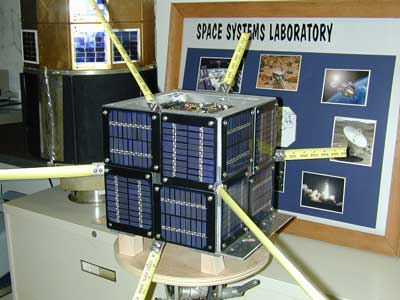
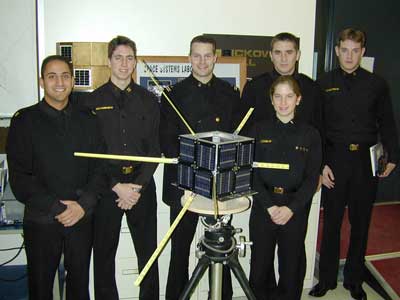
RECENT ACTIVITY:
PCsat was in full Sun 20-29 Sept, and supported full GPS operations then.
PCsat also completed its one-year anniversary at 0240z on 30 Sept 2002.
See note.
On 2 October, eclipses were up to 27 minutes long, but PCsat was still holding its
command set without a reset. But as soon as we get a reset, PCsat will be back to SUNSHINE
only operations as she continues to deep cycle her Nicads on every orbit to eventual
failure.
SUMMER SUMMARY:
Between 6 to 16 August, PCsat returned to normal ops (Day and night) as eclipse periods dropped from
the usual 35% down to 30% thus improving the power budget into positive range for about a
week. We conducted comms experiments with four of our sailboats on summer
cruise and tracked them automatically on almost every pass. Ted Rogers KH6JJD made this
summary and this
detail plot
of his satellite successes from his boat. On 16 Aug, PCsat returned
to DAYLIGHT only operations.
PCsat was in full Sun from 8-23 June and was fully operational for a variety of GPS
tests. Unfortunately due to an erroneous GPS command, we ran the batteries down
overnight before Field Day so that PCsat was quite unusable on 22 June.
But by the next day, PCsat was back to full power and with many new
users. On 27 June we conducted a USER LOAD test and with 56 users trying, we achieved
a 97% success rate. (See report). Also during this time
we were able to complete analysis on the following data:
See 16 hour plot of Battery volts
Solar Panel Spin Plot
GPS SNR Spin Plot
From 10 May to 8 June, PCsat was in maximum eclipse cycle and we had to turn off the digi.
When we do this, the callsign changes to NODIGI as a means of alterting USERS to this
situation. PCsat is now in its fourth such low power period where it experiences
over 380 deep cycles on its batteries...
See 6 Mar-10 Apr report, and
recovery! During these periods we depend on the dedicated
efforts of G6LVB, IT9GSV, LU7ABF, LW2DTZ, VK3JT, WB4APR, ZL1AOX, ZR1FN, ZR1CBC, VK2XGJ,
to keep us in the best power situation...
See the Full Analysis and plots of PCsats Orientation with
the sun and predictions of improving solar angles!
NEW ITEMS:
PCsat Operations at Field Day 2002
ISS-PCsat joint test plan (A short test to fly to DIGI's in space on same frequency)
EZNEC Plot of PCsat GPS antenna.
USER LOG as of 9 April (1118 calls). Produced from Steve
Dimse's FINDU.COM.
Z axis Wobble as determined from +Z array currents.
Solar Incidence angle and its effect on the loss of the -Z panel (by ZR1CBC).
Solar Panel I-V curves. and Solar Panel Power Plot. .
Graphics Telemetry Summary from 1 Dec to 10 March.
Thanks to Steve Dimse's FINDU.COM.
The first Remote Traveler signs up for PCsat wilderness access.
See Map of area,
his position, or
his MSGS .
Download PCSAT.EXE for
decoding PCsat telemetry and keyboarding via PCSAT and ISS.
ISS returns to packet! PCsat operates in Synergy by also supporting the ARISS digi path!
PCSAT.APRS.ORG shows the LIVE downlink captured from PCsat.
www.ariss.net shows the LIVE downlink from the International Space Station
Click Here for a video of the Launch!
How to send Email via PCsat (or other APRS satellites).
Recommended UNPROTO paths for normal operations.
(See Eclipse Plot) .
SAPPHIRE Activated: On 28 Jan, Sapphire has been activated for APRS/UI
digipeating on a limited basis (no unattended operation). Please
review the user service agreement .
for details.
PRI-COMM Activated:
On 24 Jan we activated the experimental PRI-COM feature on PCsat which can capture
Emergency and Priority messages from the THD7 and D700 anywhere on the planet and
hold them for retransmission over the USA on 144.39.
See details. VE4DS is our first user as he drives
the 300km ice bridge in the Canadian Northwest Territories.
The first Remote Traveler.

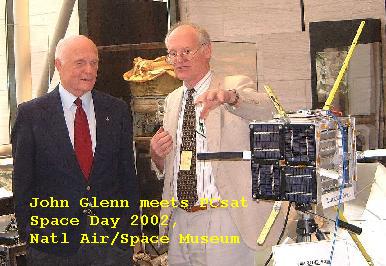
OPERATING ITEMS and EVENTS:
Remote Environmental Sensing: PCsat has a low power uplink receiver for remote experiments.
See Buoy Project
New PCSAT.EXE (DOS) operations and telemetry program released
(download)
PCsat Special Event! 12 December commemorated the 100th anniversary of Marconi's
transatlantic Radio transmission and the 40th anniversary of the first Amateur Satellite
OSCAR-1 launched in 1961. PCsat heralded the event around the world by
transmitting Marconi's letter "S" and OSCAR-1's "HI HI" once every 3 minutes in Morse code.
See Details.
PCsat Mobile Command Station: See our mobile Command station for 24/7 Operations:
(See details)
Flying APRS in an F-16 experiment The following photo shows an APRS experiment
flying in an F-16 for real time tracking...
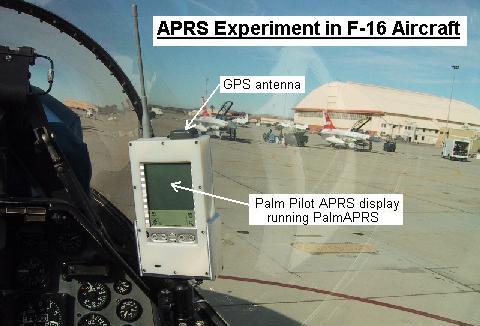
PCsat, a Prototype Communications Satellite, is a US Naval Academy Aerospace
student project designed to give students real
hands on experience in satellite design and operations. The project was
funded by the Naval Academy, and a Grant from Boeing Corporation, and the launch was secured
through the DOD's Space Test Program in cooperation with NASA. The project is the first
of the USNA Small Satellite program under the guidance of LTCL Billy Smith and supported by
the Satellite Project Engineer, Bob Bruninga, WB4APR.
The mission,
to fit within the ITU regulations for operations in the Amateur Satellite Service,
is to provide mobile and Handheld Satellite digital communications for amateur satellite operators
worldwide using the Automatic-Packet-Reporting-System (APRS). PCsat augments the terrestrial
APRS system (See LIVE map)
with a flying worldwide Relay to extend APRS coverage globally. To see those users relaying
their data via PCsat only, see Steve Dimse's
PCSAT.APRS.ORG.
This mission demonstrates mobile vehicle tracking and communications for
GPS equipped remote travelers such as the
Naval Academy Boats at sea, cross country travelers,
expeditions, or any other travelers which are far from any existing
APRS terrestrial tracking infrastructure.
The PCsat satellite downlink from such travelers is fed into the existing
worldwide internet linked APRS system by several volunteer ground stations. PCsat
is the first satellite that was designed specifically for this APRS mission.
It follows from many experiments that we conducted over the last few years on ISS, MIR,
SUNSAT
and the older AO-16, IO-26 and LU-19 birds.
(ASTARS)
For those remote areas of the world where there are no IGates in the same footprint
as the wilderness or arcitc traveler, PCsat also has a limited
Emergency Status and Reporting (SAR) capability that can be used by a few such travelers.
As an example of the PCsat mission, here is a photo we just received of one of our
graduated students testing PCsat from his Boat.
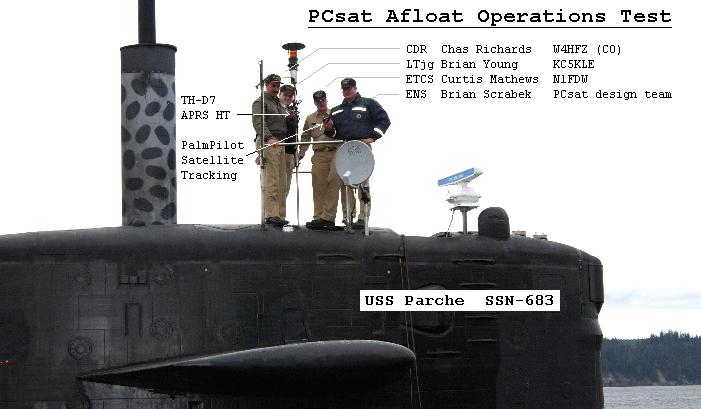
Launch was at 0240z 30 Sept 2001 from the
Kodiak Alaska Launch Complex.
You can easily track PCsat with any tracking program as NORAD object number 26931. or
try Heavens-above.com .
User Services: PCsat was activated for users as of 1930z on 3 Oct and demonstrated
(photos) at the 2001 AMSAT
Symposium in Atlanta, GA on 5 Oct.
Note
that due to frequent resets to SAFE mode on orbit which causes PCsat to revert to its
pre-launch callsign of W3ADO-1, unless you see bulletins to the contrary, you are welcome
to digipeat via W3ADO-1. Even when we load PCSAT-1 callsign, one of the UI aliases will
be set to W3ADO-1 so that it may continue to be used. Users should
read and affirm the PCsat User Service Agreement.
PCsat is
a unique design with NO CPU other than two TNC's, and a unique mission for everyone. In this
context it is different from all other amateur satellites. We hope you will adhere to the
User Service Agreement
(1 packet per 2 minutes for routine unattended ops) so that as many people as possible get to
operate via PCsat reliably.
The following graphic shows the first
4 orbits starting at separation off the coast of Somalia
70 minutes after launch. The graphic shows what populations of
amateur satellite operators first heard signals. As of 0600Z we had heard
of confirmations from our
Launch Information Network of key stations.
(See MAP).
Early Reports then came in from Alaska, Hawaii,
the SANAE station in Antarctica),
and South Africa and in the next 12 hours from everyone around the world.
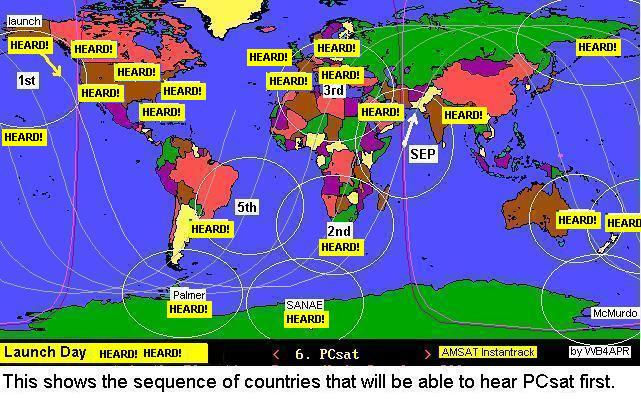
PCsat was an auxilliary payload on the Kodiak Star mission which has a total of 3 amateur satellites
on board.
The Sapphire satellite
is also a Naval Academy mission in a joint venture with Washington University.
Starshine is
the primary NASA payload and it also uses APRS style telemetry packets.
The following frequencies are used:
145.828 1200 baud PCsat downlink (Telemetry, and low-power stations)
145.828 9600 baud PCsat downlink (Telemetry, Mobiles and higher power stations) (OFF to save pwr)
144.390 1200 baud PCsat downlink over USA for brief PCsat posit and Telemetry
145.828 9600 baud Starshine downlink (Telemetry 1 packet per 2 minutes) (OFF to save pwr)
437.100 1200 baud Sapphire downlink (and Voice synthesizer)
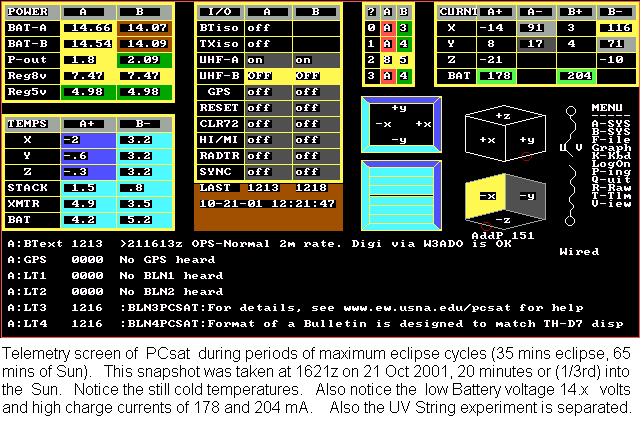
Click here to see the telemetry 50% through the
sunny side during periods of maximum eclipse.
Click here to see eclipse plot for next 6 months.
And here for next year.
COMPLETE TELEMETRY PLOTS: Click Here for
complete telemetry graphics covering the period from 1 Dec to 10 March 2002. This
data was generated by Steve Dimse's FINDU.COM which is an SQL data base holding all
APRS packets captured worldwide.
Here are several additional PHOTOS, DRAWINGS and Documents reorganized by topic:
SPECIAL EVENTS!
ARMY/NAVY Football Run: On 30 Nov, 120 Midshipmen from 13th Co ran
the annual A/N Game ball from Annapolis, MD to the game in Philadelphia over 150 miles
and 24 hours. PCsat was used to help update the
FBALL Web page which
tracked the positions of the Ball and Chase vans
and members of the USNA Radio Club providing communications for the event.
LED Experiment: At 1929 EST on 25 Nov, we repeated the LED experiment
as PCsat passed from sunlight to Eclipse over Atlanta. Most of the East Coast was socked in
by clouds but stations in Texas had a good view.... of the Moon! It was too bright to see
PCsat. We will reschedule in a few months when things line up again.
This LED radiator consists of 80 standard RED LED's
and might be visible to someone
with binoculars if it points in their direction. Phillip Masding and Mike Tyrrell
who frequently
photograph the Space Station via their telescopes will watch for us next time.
STATUS AND LAUNCH INFO:
Launch Monitoring Team Plan
PCsat USA Nationwide Paging system
Telemetry format and equations
Press Release
PCsat tracking WEB paged by DLR
PCsat User Service Agreement
Frequencies (2m downlink)
DESIGN and OPS PLAN
PHOTO VIEWS:
Ultraviolet Release Experiment
Photos of the +Z View,-Z View,
-Y View
The Prototype
Working Prototype
Wiring Harness (so far)
MECHANICAL DETAILS:
Vibration spec
Upper bay stack
Stacking and Wiring Plan
TNC mods for telemetry
Vibration Test and Antenna Photo
Structure and Frame (photo)
Solar Panel/power simulation (photo)
ANTENNA AND EXTERIOR DETIALS:
Antenna Sketch / Launch Configuration
Dimensioned Antenna Launch Envelope
Internal sketch showing optional GPS location
Optional bottom Solar Panel
MODULE DETAILS:
TNC/XMTR/RCVR diagram
Terminal Node Controller (photo)
VHF 3 Watt Transmitter (photo)
VHF receiver (photo)
UHF receiver (photo)
KPC-9612 Sixteen Channel Telemetry Circuit
Final Telemetry Board
The Space segment of PCsat has been demonstrated a number of times in space via
MIR School tests, the Shuttle SAREX,
and the SPRE mission. . It is also a spin off of an previous
launch opportunity that we had in 1998 called NATSweb that
almost got launched on SEA-LAUNCH..
PCsat is a project to produce a viable spacecraft in a very short time frame using off
the shelf components where possible. Here are the background topics of design:
The Mission and PCsat Team
Frequency Request and Mission details
The Design
User Routing Paths via PCsat
Power System
Link Budgets
Cooling Experiment
My Solar Prius
APRS is the Automatic Packet Reporting System that the Naval Academy uses for
tracking its boats and a variety of other vehicles and networks using the
APRS
Automatic Packet Reporting System . The Satellite described here in would be
operated under the rules of the Amateur Satellite Service and the rules of the FCC.
Although the satellite would be developed as a proof of concept for the Naval Academy,
it would be available for all radio amateurs and their vehicles.
You are visitor:
 since 17 Feb 2001 when old counter was lost.
Average hits have moved up from about 1000 to 2000 per week.
since 17 Feb 2001 when old counter was lost.
Average hits have moved up from about 1000 to 2000 per week.
WA8LMF Mirror of WB4APR Website - 21 July 2008
 PCSAT-1, A Naval Academy Amateur Radio Satellite
PCSAT-1, A Naval Academy Amateur Radio Satellite




 There are a few remote environmental sensor projects that use PCsat or its cousins of
ISS or UO22 for reporting remote data back to the worldwide APRS system. This one is
in the Arctic and there are
There are a few remote environmental sensor projects that use PCsat or its cousins of
ISS or UO22 for reporting remote data back to the worldwide APRS system. This one is
in the Arctic and there are








